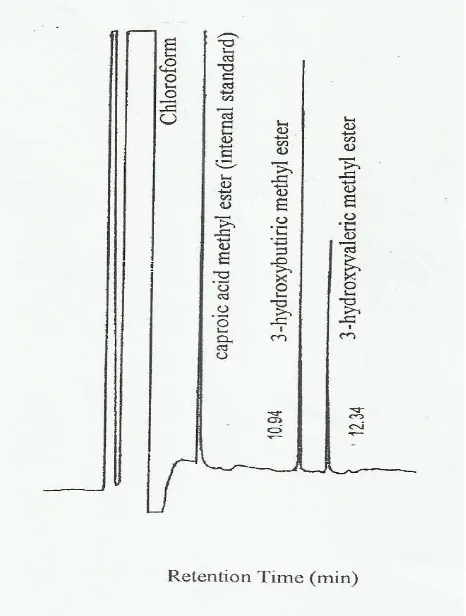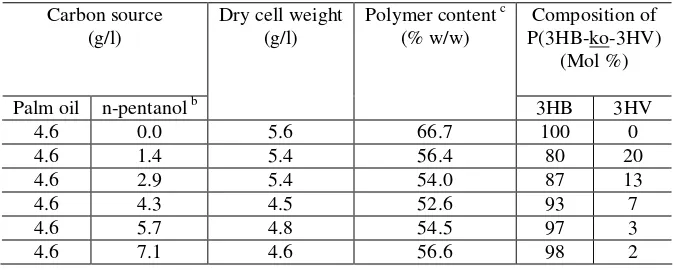ISSN: 0974-1496 | e-ISSN: 0976-0083 | CODEN: RJCABP http://www.rasayanjournal.com http://www.rasayanjournal.co.in
BIOSYNTHESIS OF COPOLYMER POLY
(3-HYDROXYBUTYRATE-CO-3-HYDROXYVALERATE) FROM
PALM OIL AND N-PENTANOL IN A 10L BIOREACTOR
D. Akmal
1*, P.D. Asiska
1, Q. A. Wangi
1, H. Rivai
1and A. Agustien
21
Faculty of Pharmacy, University of Andalas, Padang, Indonesia
2
Departemen of Biology, Faculty of Sciences, University of Andalas, Padang, Indonesia
*E-mail: [email protected]
ABSTRACT
The production of poly (3-hydroxybutyrate-co-3-hydroxyvalerate) copolymer, P (3HB-co-3HV) from palm oil and a second carbon source by using bacteria Erwinia sp. USMI-20 in a 10L bioreactor has been done. Fermentation process was conducted through a single stage batch cultivation method under aerobic condition at pH 7.0, incubation temperature of 30 oC, and an agitation rate of 200 rpm for 66 hours. The production of the biopolymer was done from an initial growth on palm oil with a subsequent single feeding of n-pentanol.In this case, n-pentanol was used as a second carbon source to introduce the mole fraction of the 3-hydroxyvalerate, 3HV unit. The characterization of the polymer production was supported cell growth, polymer compound content and therefore the mole fraction of the 3-hydroxyvalerate unit. From this study, the composition of the polyester was noted to vary during the cultivation period. The highest amount of 3HV unit in the polyester at 48 hours of cultivation was 20 mole percent, the maximum amount of polymer content at 62.37 weight percent, biomass of 4.8 g/l and the maximum specific growth rate and specific polymer production were 0.401 hr-1 and 0.047 hr-1 respectively.
Keywords: poly (3-hydroxybutyrate-co-3-hydroxyvalerate), copolymer, palm oil, n-pentanol, Erwinia sp.
USMI-20.
©2015 RAS YAN. All rights reserved
INTRODUCTION
Many bacteria are known to synthesize poly (3-hydroxyalkanoates), P (3HAs) as carbon and energy reserve materials under certain environmental condition, such as nitrogen, oxygen, and phosphate-limitation condition1,2. P(3HAs) have been studied from various points of view, for example, synthesis of new types of P(3HAs), screening and characterization of producer strains, degradation in soil and sea, and the development of fermentation processes for mass production3,4.
At present, to reduce the cost of producing P (3HAs), it is necessary to increase the production rate, cell cultivation, P (3HA) content in the cell, as well as usual cheap carbon substrates. In any industrial-scale P (3HAs) production, the carbon source is the primary determinant for the consideration of the raw material to be used in such processes5. Accordingly, the selected carbon source should be reasonably cheap as well as enabling a high theoretical yield of P (3HA) to be achieved. One such approach has been in the use of plant oil which needs to be metabolized by the β-oxidation cycle to generate the starting molecule, acetyl-CoA for the production of P (3HB). Such a pathway has been determined to produce a conversion of as high as 0.62 weight ratio by the use of Alcaligenes sp AK 201 with palm oil against a theoretical conversion value of 1.46.
EXPERIMENTAL
Microorganism
Bacteria Erwinia sp. USMI-20 was used as a strain in this study for the production of a copolymer P (3HB-co-3HV). The characteristics of this microorganism have been described by Chen and Madjid.3, 8 Culture condition
The microorganism was grown in a single stage batch cultivation method under aerobic condition at pH 7.0 and 30°C. The growth of the microorganism was carried out in a 10L bioreactor at 200 rpm of a defined mineral medium together with refined palm oil as the carbon source. The composition of the mineral medium and the microelement solution being added to the mineral medium has been described previously4.
The batch fermentation process was conducted for 66 hours with a single feeding of n-pentanol at 20 hours. At regular intervals during the fermentation process, samples were collected, harvested, washed and lyophilized. Polyesters were then extracted from the lyophilized cells with hot chloroform in a pressure tube and purified by re-precipitation with methanol.
Analytical procedures
The cellular polymer content was determined by using a capillary gas chromatography method. 20 mg of dried cells was subjected to methanolysis with a solution consisting of 1.7 ml methanol, 0.3 ml 98% sulphuric acid and 2.0 ml of chloroform at 100°C for a minimum of 4 hours to convert the constituents to their methyl esters. On completion of the methylation reaction, addition of 1 ml water to the reaction mixture would induce a phase separation. The lower chloroform layer was used for a gas chromatographic analysis with a Supelcowax column (30 mm by 0.32 mm) and a flame ionization detector. The operating condition for the GC equipment (Perkin Elmer Auto-system XL) was as follows: detector temperature at 250°C, injector temperature at 260°C, column temperature program following a split injection, (1:100), the column temperature was held at 50°C for 5 minutes, and then programmed to 220°C at 10°C/min. The composition of the polymer samples were confirmed by analysis of 270 MHz 1H NMR spectra. The NMR was recorded on a Bruker NMR and tetramethyl-silane was used as an internal chemical shift standard.
The biomass was determined by a gravimetric measurement. The sample was centrifuged at 10,000 rpm for 15 minutes and the pellet was then removed after a washing with distilled water to remove the remaining oil. The cells were then dried in a freeze drier (B Braun FD 5505P) for 24 hours.
The amount of remaining nitrogen in the solution was determined by Berthelot reaction at the maximum visible wavelength of 625 nm9. The colorimetric reaction was formed by adding 5 µl of the aqueous
solution with 2.5 ml of a solution containing phenol (1%) and sodium nitroprusside (0.006%). Subsequently, 2.5 ml of a second solution containing 0.5% sodium hydroxide, 5.4% sodium hydrogen phosphate and sodium hypochlorite (1%) was added to the mixture. The resulting blue solution was determined against a standard calibration curve of known amounts of nitrogen.
The amount of remaining palm oil in the medium was determined by a gas chromatography method after extracting the oil with chloroform and converting the oil to their respective methyl esters. The oil was determined indirectly from the amount of palmitic acid methyl ester from the extracted oil.
The amount of remaining n-pentanol in the solution was also determined by a gas chromatography method against a standard calibration curve of known concentration of n-pentanol.
RESULTS AND DISCUSSION
The appearance of the P (3HB-co-3HV) granules in the bacteria when grown in a mineral medium containing palm oil and n-pentanol as carbon source is shown in Fig. -1. It was found that the number of granules accumulated ranging of 1 to 5 granules per-cell with diameters in the 100 to 350 nm range. For many bacteria, P (3HB) functions either as carbon and/or energy reserve or as a sink for excess reducing equivalents10. This confirms that the P (3HB) granules consist of a hydrophobic core of amorphous that is surrounded by a membrane consisting of various catabolic and non-catabolic proteins.
Fig. -1 Electron micrograph of ultra thin section of Erwinia sp. USMI-20 which shows the P(3HB-co-3HV) granules (white fraction) after cultivation in mineral medium containing a mixture of palm oil and n-pentanol.
Fig.-2: Gas chromatography analysis of the extracted P(3HB-co-3HV) copolymer produced from palm oil and n-pentanol by Erwinia sp. USMI-20 after conversion to their respective monomeric methyl esters with retention time
Based on the extraction of the polymer and the conversion of the polymer into its monomeric constituents as seen from the gas chromatographic analysis (Fig.-2), Erwinia sp. USMI-20 was shown to synthesize and accumulate the copolymer of P (3HB-co-3HV) from the utilization of palm oil and n-pentanol. The extracted copolymer on further confirmatory test by the 1H NMR and 13C NMR techniques (Fig. -3) were confirmed to be P (3HB-co-3HV).
From the characterization of the extracted polymer, n-pentanol could be utilized as the second carbon source in the production of the copolymer. This pathway represents an additional synthetic pathway for the production of the copolymer unlike that found in bacteria Ralstonia eutropha where only propionic acid could be utilized to produce the copolymer 10,11.
In this case, when the microorganism is fed with n-pentanol as the second carbon source, the incorporation of the second monomer, 3-hydroxyvalerate into the copolymer chain would involve an additional enzymatic involving an oxydase enzyme for the oxidation of n-pentanol to valeric acid 12,13. Once converted into valeric acid, the intracellular acyl-CoA synthetase would change this molecule further into valeryl-CoA. The resulting valeryl-CoA would be further transformed by a reductase enzyme to 3-hydroxyvaleryl-CoA which represents the building unit for the copolymer 14.
The monomer is then linked into the polymeric chain through the action of a synthetase enzyme. In addition, the other monomer unit for the copolymer, namely, 3-hydroxybutyrate, is also synthesized through the same pathway. The difference being the monomer is derived from the condensation of two acetyl-CoA molecules to form acetoacetyl-CoA 15-17. The acetoacetyl-CoA is then converted into 3-hydroxybutyryl-CoA before being linked to the main chain of the polymer.
Table -1 showed that the effect of different n-pentanol concentrations as a second carbon source in the culture on the biomass production, the content and composition of the synthesized P(3-HB-co-3HV) from palm oil by Erwinia sp. USMI-20. The maximum amount of 3HV unit was obtained from a single feeding of 1.43 g/l n-pentanol.
Table-1: Effect of different concentrations of n-pentanol as a single feeding in mineral medium containing palm oil 4.6 g/l on the growth and P (3HB-co-3HV) synthesized by Erwinia sp. USMI-20a.
Carbon source
a Incubation time 48 hours, temperature 30°C, pH 7.0 and agitation 200 rpm. bA single feeding of n-pentanol at 20 hours post-incubation
cPolymer content calculated from biomass.
Fig.-4: Time course of the biosynthesis of a copolymer P (3HB-co-3HV) from palm oil and n-pentanol.
The maximum amount of the co-monomer, 3-hydroxyvalerate, that could be incorporated in the polymer chain was 20 mole percent. Based on the derived values from this time dependent experiment, it is also observed that the maximum specific growth rate and specific polymer production were 0.401 hr-1 and 0.047 hr-1 respectively.
CONCLUSIONS
ACKOWLEDGEMENTS
The authors would like to acknowledged Ministry of Education and Culture, Government of Indonesia, for its support through Hibah Kompetensi (HIKOM) Research Grant, University of Andalas, Padang, Indonesia.
REFERENCES
1. J. Tian , A. Sinskey , J. Stubbe, Journal of Bacteriology, 187, 3825(2005). 2. O. P. People, K.D. Snell, Biofuels Bioproduct Biorefining, 3, 456(2009).
3. M. I. A. Majid, D. Akmal, L. L Few, A. Agustien, M.S. Toh, M.R. Samian, N. Najimudin, M.N. Azizan, International Journal of Biological Macromolecules, 25, 95(1999).
4. D, Akmal, M.N. Azizan, M. I. A Majid, Polymer Degradation and Stability, 80, 513(2003). 5. T. Yamane, Biotechnology and Bioengenering , 41, 165(1993).
6. M. I. A. Majid, K. Hori, M. Akiyama, and Y. Doi, In. Biodegradable Plastics andPolymers (Eds. Y. Doi and K. Fukuda), Elsevier Science B.V., Amsterdam, pp. 417-424 (1994).
7. D. Akmal, M. I. A. Majid, M. S. Razip, M. N. Nazalan, and M. N. Azizan, TheInternational Symposium on Biological Polyhydroxyalkanoates, Tokyo, Japan, (1998).
8. D. Akmal, L. Fitriani, Q. A. Wangi, P. D. Asiska, I. Friardi, Z. Erizal, Research Journal of Pharmaceutical, Biolological and Chemical Sciences, 6(1), 814(2015).
9. Y.W.Lee and Y.J. Yoo, Korean Journal of Application Microbiology and Biotechnology Letter, 14, 811(1994).
10. Y. Doi, Microbial Polyesters. VCH, New York, pp. 1-23 (1990).
11. T. Fukui, Y. Doi. Application of Microbiology and Biotechnology, 49, 333(1998). 12. M. Beeby , M. Cho, J. Stubbe, Journal of Bacteriology, 194, 1092(2012).
13. A. Steinbuchel, H. E. Valentine, FEMS Microbiology Letter, 128, 219(1995)
14. W. J. Page, A. Cornish, Application of Environment and Microbiology, 59, 4236(1993) 15. G. M. York, J. Stubbe, A. J. Sinskey, Journal of Bacteriology, 184, 59(2002).
16. J. Tian , A. J. Sinskey, J. Stubbe, Biochemistry, 44, 8369(2005).
17. D. Akmal, M. R. Marjoni, I. Friardi, Research Journal of Pharmaceutical, Biological and Chemical Sciences, 6(3), 583(2015)

